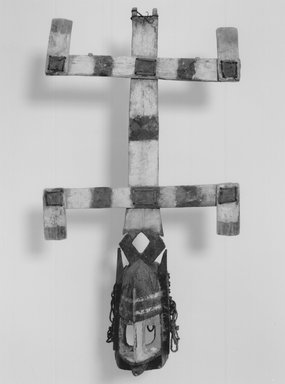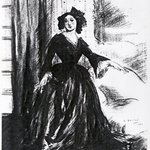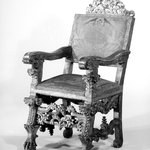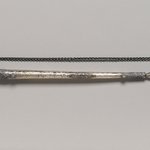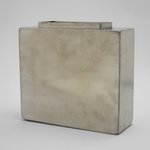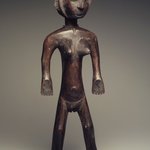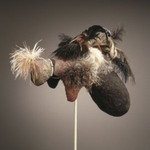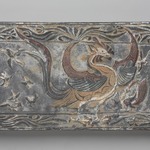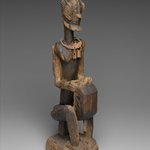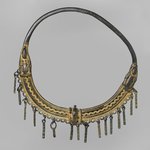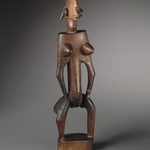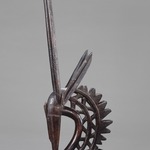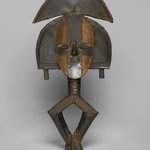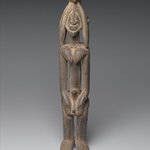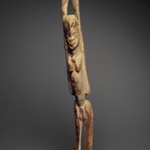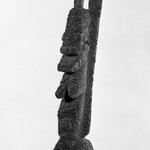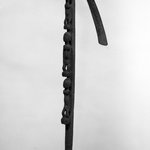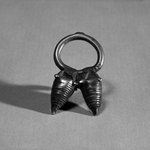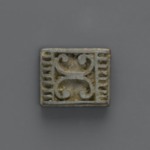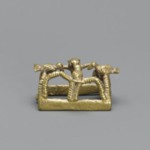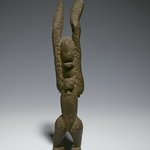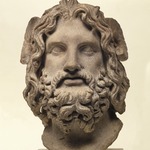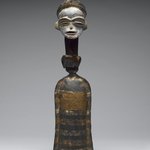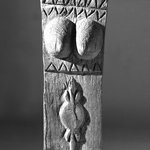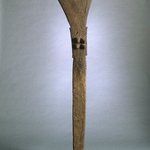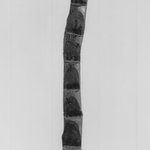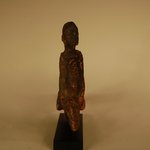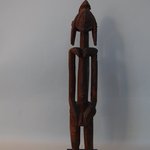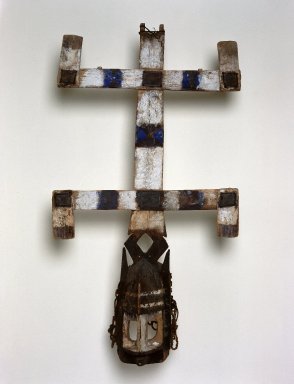
Mask (Kanaga)
Arts of Africa
Masks may be used at funeral ceremonies to honor and commemorate the dead as they enter the ancestral realm. Dogon dancers perform with kanaga masks at dama ceremonies honoring the dead (see the video at left). Rotating their upper bodies from the hips and swinging the masks in wide circles, the dancers imitate Amma, the creator god, who brought all things to life. Their outstretched movements symbolically spread the force of life throughout the world.
CULTURE
Dogon
MEDIUM
Wood, leather, pigment, vegetable fiber
DATES
20th century
DIMENSIONS
42 1/2 x 23 1/4 x 9 in. (108 x 59.1 x 22.9 cm) (show scale)



COLLECTIONS
Arts of Africa
ACCESSION NUMBER
1995.171.11a-c
CREDIT LINE
Gift of Allen C. Davis
CATALOGUE DESCRIPTION
Mask with a wooden superstructure in the form of a double barred cross with short vertical elements projecting from the tips of each horizontal bar. Center of face protrudes, while sides on lower portion of face cut away. White pigment on face and superstructure, blue pigment and leather squares on bars. Netted rope fiber attached to sides of facial mask. Condition: worn. Heavy encrustations of organic matter. Paint fragmentary. Surface abrasions throughout.
EXHIBITIONS
MUSEUM LOCATION
This item is not on view
CAPTION
Dogon. Mask (Kanaga), 20th century. Wood, leather, pigment, vegetable fiber, 42 1/2 x 23 1/4 x 9 in. (108 x 59.1 x 22.9 cm). Brooklyn Museum, Gift of Allen C. Davis, 1995.171.11a-c. Creative Commons-BY (Photo: Brooklyn Museum, 1995.171.11a-c_SL1.jpg)
IMAGE
overall, 1995.171.11a-c_SL1.jpg. Brooklyn Museum photograph
"CUR" at the beginning of an image file name means that the image was created by a curatorial staff member. These study images may be digital point-and-shoot photographs, when we don\'t yet have high-quality studio photography, or they may be scans of older negatives, slides, or photographic prints, providing historical documentation of the object.
RIGHTS STATEMENT
Creative Commons-BY
You may download and use Brooklyn Museum images of this three-dimensional work in accordance with a Creative Commons license. Fair use, as understood under the United States Copyright Act, may also apply.
Please include caption information from this page and credit the Brooklyn Museum. If you need a high resolution file, please fill out our online application form (charges apply).
For further information about copyright, we recommend resources at the United States Library of Congress, Cornell University, Copyright and Cultural Institutions: Guidelines for U.S. Libraries, Archives, and Museums, and Copyright Watch.
For more information about the Museum's rights project, including how rights types are assigned, please see our blog posts on copyright.
If you have any information regarding this work and rights to it, please contact copyright@brooklynmuseum.org.
RECORD COMPLETENESS
Not every record you will find here is complete. More information is available for some works than for others, and some entries have been updated more recently. Records are frequently reviewed and revised, and we welcome any additional information you might have.
